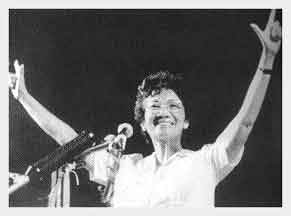1986 Marcos Flees the Philippines

Hong Kong
On February 7th, President Ferdinand Marcos, ruler of the Philippines for 20 years, ran for re-election against Corazon Aquino, widow of slain opposition leader Benigno Aquino. Marcos had Parliament declare him the winner, even though Aquino had actually won. Mass demonstrations ensued and Marcos was forced to flee when the army refused to put down the demonstrations.
The events leading up to Marcos' downfall in 1986 began years earlier, but the tipping point was undoubtedly the assassination of Benigno Aquino Jr., a popular opposition leader and Marcos' primary political rival, in 1983. Aquino was shot dead moments after returning from exile in the United States. Marcos, whose administration was blamed for the assassination, came under increasing international and domestic pressure.
In late 1985, in an attempt to quell the growing unrest, Marcos announced a snap presidential election to be held in February 1986. Corazon Aquino, the widow of Benigno Aquino Jr., decided to run against Marcos. The election was marred by widespread allegations of vote-rigging and violence. Marcos declared himself the winner despite clear indications that Aquino had received more votes.
The controversial election results ignited mass demonstrations across the country, commonly referred to as the People Power Revolution. The protests were peaceful, with participants using flowers, prayer, and non-violent resistance to express their opposition to the Marcos regime. They received wide international attention and were notable for the support of the Catholic Church in the Philippines, led by Cardinal Jaime Sin.
The pivotal moment came when two key Marcos allies, Defense Minister Juan Ponce Enrile and Armed Forces vice chief of staff Fidel V. Ramos, defected to the opposition. They barricaded themselves in two military camps in Metro Manila and declared their support for Aquino.
This led to a tense standoff, with loyalist troops ready to attack the rebel camps. However, millions of Filipino civilians formed human barricades around the camps to protect the rebels. When Marcos ordered his troops to attack, they refused. The refusal of the military to support Marcos was a crucial turning point. It signaled the loss of Marcos' control over the government.
On February 25, 1986, Corazon Aquino was sworn in as the 11th President of the Philippines, in a simple ceremony at Club Filipino in San Juan. In a desperate attempt to maintain control, Marcos held his own inauguration ceremony at Malacañang Palace the same day. However, later that night, with his regime crumbling, Marcos and his family fled the country.
They were airlifted by the United States to Hawaii, marking the end of his 20-year rule and the beginning of a new era in Philippine history known as the Fifth Republic. The People Power Revolution remains a significant moment in Philippine history, symbolizing the power of nonviolent resistance and the end of a long period of dictatorship. Corazon Aquino's presidency represented a return to democracy for the Philippines.
 >
>